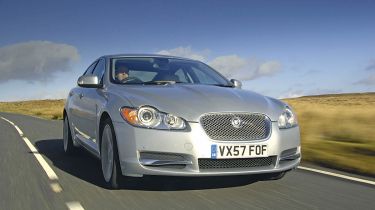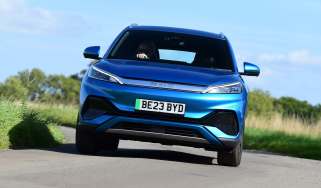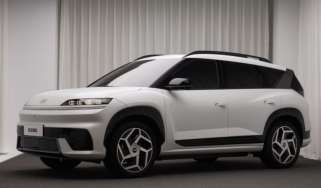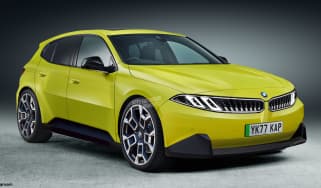Jaguar XF 2.7D Luxury
It looks great, but is the big cat good enough overall to beat the best?
The XF “is the beginning of a new era for Jaguar” – those are the company’s own words. This seems an odd claim given that the saloon shares its basic frame with its predecessor, the S-Type, and has exactly the same wheelbase measurement. You would have expected engineers to use a modified version of the XK’s platform, for example.
Still, elsewhere it’s more a case of revolution than evolution. The XF is said to have the quietest engine in the executive car class, as well as the best torsional stiffness, while it has been constructed using very high strength steels.
Video: watch CarBuyer's video review of the Jaguar XF
[[{"type":"media","view_mode":"content_narrow","fid":"68287","attributes":{"alt":"","class":"media-image"}}]]
You’ve got to admit the model has been well shaped by Jag chief designer Ian Callum and his team. We have reservations about the front end – the grille looks a bit low from some angles, and is an obvious attempt to retain a classic Jaguar feature. But wherever else you look, the styling is bold, modern and appealing.
The strong shoulders, high tail and shallow rear screen angle give it the stance of a coupé, and up close it’s difficult to spot any obvious weaknesses. We were particular impressed with the solid construction of the mesh grille, the neat LED tail-lights and the reflective chrome exhaust liners – at night, it looks as though there’s a torch being shone out from the inside.
Overall, it comes across as sleek and svelte. But on a day-to-day basis, owners are more likely to be concerned about practicality. Traditionally, this has been a Jaguar weak point, although the XF’s high tail means it has a 500-litre boot – or 540 litres if you do without the optional space saver spare and include the underfloor area.
Even though it’s the longest car here, the big cat has the weakest packaging – it trails both its rivals for rear legroom, with a measurement of 725mm. Headroom is tolerable rather than exceptional, too, although the XF’s back seats still provide more than enough space for two.
Maybe Jaguar hopes occupants will be too busy admiring the cabin architecture to worry about the room. This is the most striking and beautifully executed interior we’ve seen in an executive saloon.
It’s at its best at night, when a turquoise glow illuminates not only the switchgear, but also the door panels. The layout is simple, logical and as easy to get on with as the Merc’s. Neat features include the touch-sensitive interior lights and glovebox release. Yet the highlight is the centre console – in particular the JaguarDrive Selector. The gearlever dial pops up when you press the engine start button, and is so logical to use, you ask yourself why nobody has thought of it before.
While it’s unmodified for the XF, the 2.7-litre diesel was always one of the smoothest engines available in the S-Type, and nothing has changed. Although the noise figures suggest otherwise – our meter read 68dB at 70mph – the XF V6 is the least intrusive. The engine is the most impressive all-round, too. It couldn’t match the pace of the manual BMW, yet in day-to-day driving that’s not so vital. What made the Jag so good was the twin-turbo’s minimal lag, the swift, smooth gearchanges and how silent it was – especially compared to the 5-Series.
This is due to the secondary bulkhead and dual-insulated subframe, which ensure barely any noise can filter back into the cabin. However, we were slightly disappointed by the amount of wind intrusion from round the glass area. After driving the E-Class, it felt as though a window had been left ajar in the Jag. Finding fault with the driving experience in other areas was much harder. The ride was tauter than we expected, but we’re putting the blame for this squarely on the fact that our car wore optional 19-inch alloys. Expect the standard 17-inch rims to deliver greater comfort.
Nevertheless, the damping is tuned to perfection. It wasn’t as soft and silent as the Mercedes on motorways, but the XF still managed to glide effortlessly over rough surfaces. Plus, it also boasted wonderfully incisive steering, allowing the grippy front end to slice into corners with great grip and poise. In fact, it left the BMW looking like a bit of a bruiser in comparison – the 5-Series simply could not match the finesse and sensitivity of the Jaguar’s handling.
The XF doesn’t disappoint in terms of equipment, either. Our £33,900 Luxury model is the base car, but gets Bluetooth, sat-nav and a host of other goodies. Let’s see what Mercedes and BMW can do to hold off the British challenge.
Details
Price: £33,900
Chart position: 1
WHY: The twin-turbo diesel will be the top-selling XF. It’s on sale, along with three petrol versions, in March.
Economy
It’s the biggest and heaviest car of our trio, but the XF has the best aerodynamics of any Jag ever. What’s more, its relaxed road manners enabled it to return 35.4mpg – very close to its claimed economy figure of 37.6mpg, .
Residuals
it’s not only private buyers who care about resale values; the figures affect contract hire rates for fleet users, too. The XF retains 47.9 per cent of its value after three years – the best on test – which helps to give it the lowest running costs as well.
Servicing
The British marque has a strong advantage here. The first services for the XF come to £1,015, which is cheaper than either rival. Even better, the Jag network finished an impressive sixth out of 32 in our Driver Power 2007 dealer survey.
Tax
WHILE the 2.7-litre twin-turbo diesel is effortlessly smooth, it’s unchanged from the engine in the S-Type. In this company, it’s not especially clean, and its 199g/km CO2 emissions mean higher-band owners will pay £3,932 a year in tax.







